Many of us know that 1 in 20 Google searches are health related, and that more consumers are going online for health information than ever before. But do we really understand the way they find, search, interact, and act upon health-related content online?
This summer, dotHealth conducted a nationwide survey of 1,509 online respondents across the country and asked them about their activities surrounding health online (website, mobile apps, interactive tools, internet-based communication, etc.).
Unsurprisingly, we found that a majority of our respondents reported they go to the internet first when researching information about a specific health condition or question—specifically, 57% of consumers go online first vs. 32% that would go to their doctor or other healthcare professional first. When we break this down by gender, we find that women (63%) are more likely to research on the internet first then men (52%).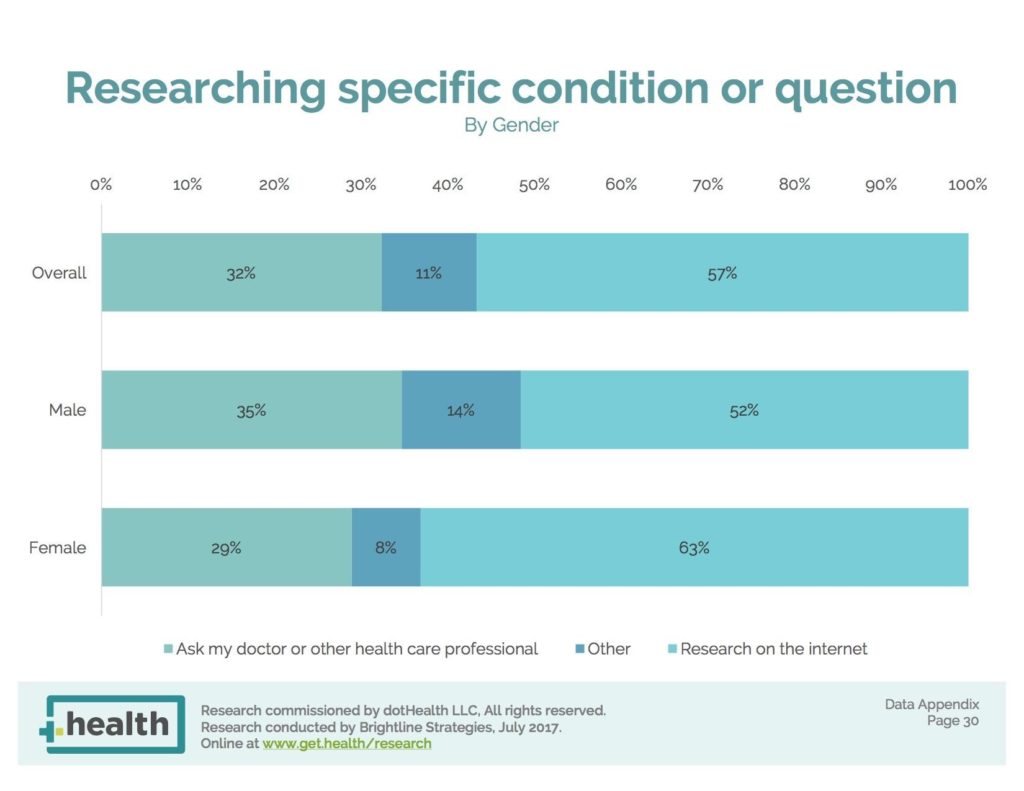 The number one most common health-related activity online of our respondents was researching a specific disease or medical condition, which 48% of them had done in the past 12 months. Similarly, more than 40% also said they had researched symptoms, specific treatments, procedures, or drugs. These research activities occurred among significantly more of our respondents than other activities such as searching for healthcare providers, researching diet and exercise plans, communicating with healthcare providers, researching health insurance, and purchasing health-related products, insurance, or services.
The number one most common health-related activity online of our respondents was researching a specific disease or medical condition, which 48% of them had done in the past 12 months. Similarly, more than 40% also said they had researched symptoms, specific treatments, procedures, or drugs. These research activities occurred among significantly more of our respondents than other activities such as searching for healthcare providers, researching diet and exercise plans, communicating with healthcare providers, researching health insurance, and purchasing health-related products, insurance, or services.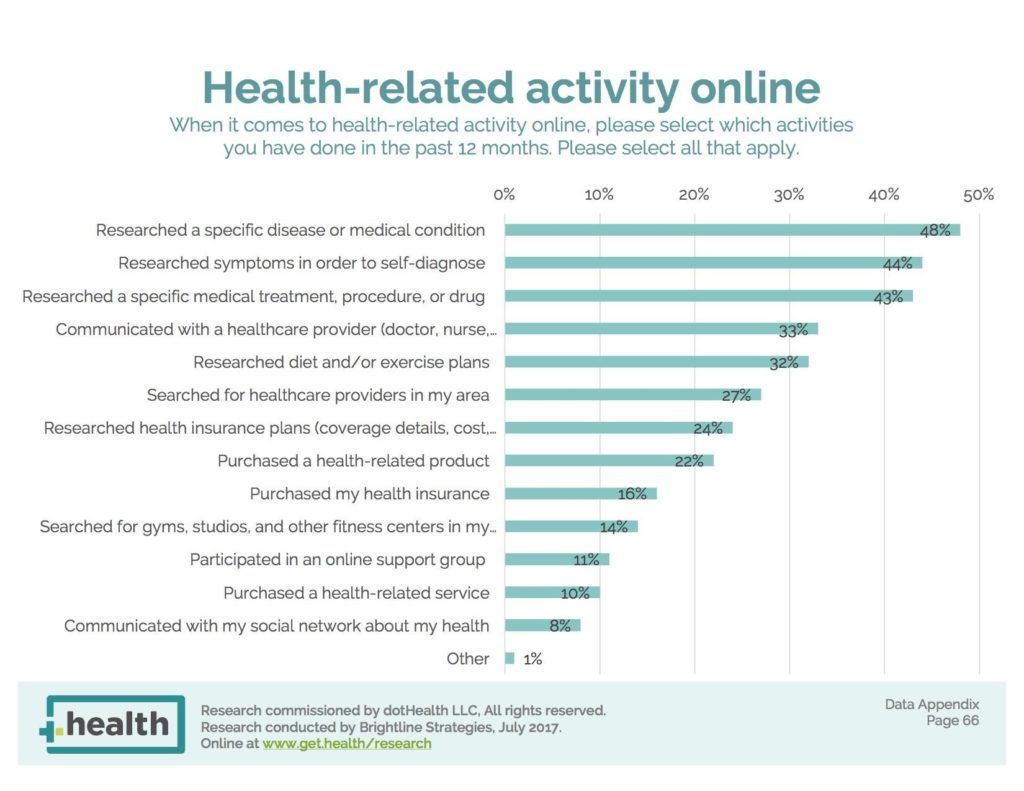 Older Americans are more likely to research a specific disease or medical condition, with 34% of 18- to 24-year-olds recording having done this online in the last 12 months vs. 59% of those 65+. Seniors are also more likely to research a specific treatment, procedure, or drug, with only 29% of 18- to 24-year-olds having done this versus 51% of the 65+.
Older Americans are more likely to research a specific disease or medical condition, with 34% of 18- to 24-year-olds recording having done this online in the last 12 months vs. 59% of those 65+. Seniors are also more likely to research a specific treatment, procedure, or drug, with only 29% of 18- to 24-year-olds having done this versus 51% of the 65+. One of the surprising findings from our report was that 43% of our respondents said they tend to look first to a trusted health website (e.g., WebMD, Mayo Clinic, etc.), when gathering information online, vs. 29% who said they tend to go to Google, Bing, or another search engine first. We found that those in higher income levels tend to rely more on trusted health websites than those in lower income levels, as well as women and older Americans.
One of the surprising findings from our report was that 43% of our respondents said they tend to look first to a trusted health website (e.g., WebMD, Mayo Clinic, etc.), when gathering information online, vs. 29% who said they tend to go to Google, Bing, or another search engine first. We found that those in higher income levels tend to rely more on trusted health websites than those in lower income levels, as well as women and older Americans.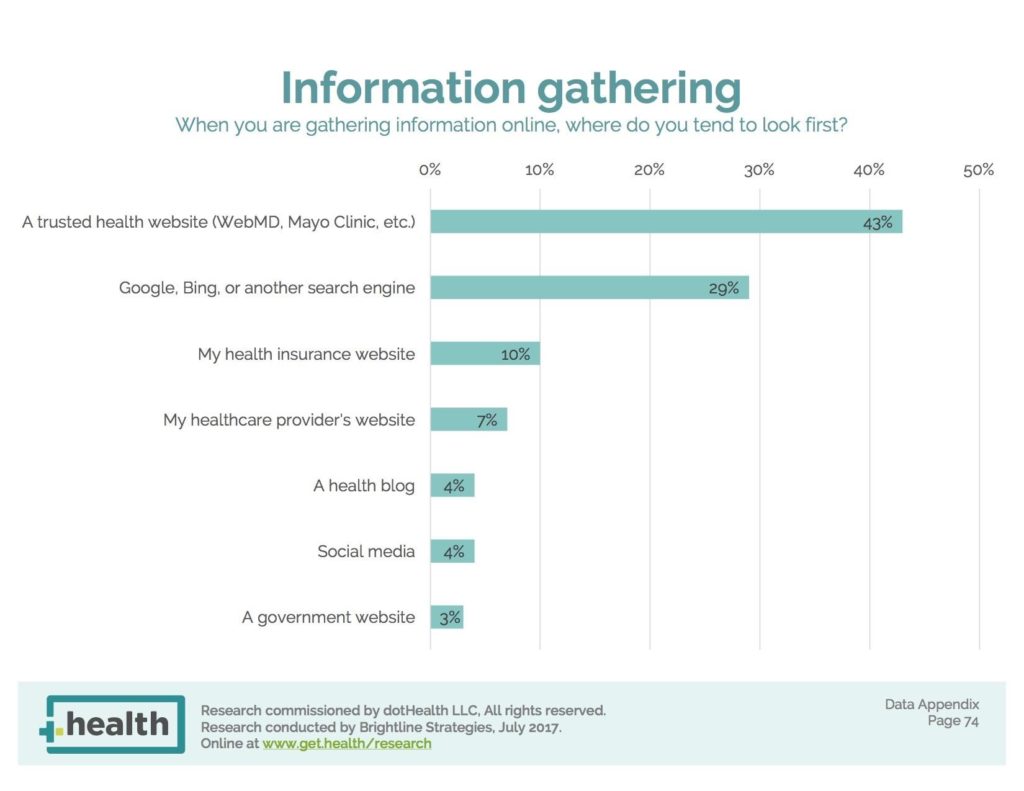 We also asked our respondents about what referral source is most trustworthy to them. Perhaps unsurprisingly, our respondents by far trusted websites the most that were recommended to them by their hospital. The next most trustworthy referral source was friends or family members, followed by government or public health agencies. While pharma and med device companies were the least trusted, they were not far behind other sources and did not appear to be a complete turn off on the trustworthy scale (at least 70% said they were at least somewhat likely to trust the information on sites recommended by pharma or med device companies).
We also asked our respondents about what referral source is most trustworthy to them. Perhaps unsurprisingly, our respondents by far trusted websites the most that were recommended to them by their hospital. The next most trustworthy referral source was friends or family members, followed by government or public health agencies. While pharma and med device companies were the least trusted, they were not far behind other sources and did not appear to be a complete turn off on the trustworthy scale (at least 70% said they were at least somewhat likely to trust the information on sites recommended by pharma or med device companies).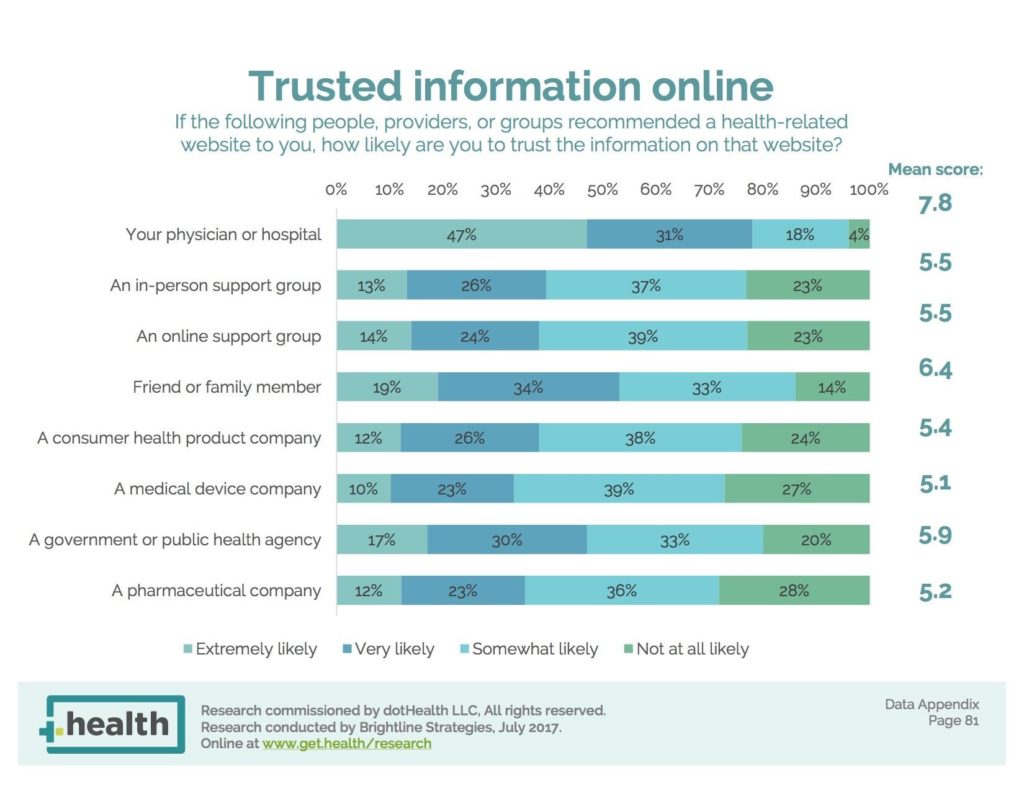 Of course, we asked our respondents if their doctor had recommended them any online resources (other than their practices portal). We found that 41% of those 18 to 24 reported that their doctor had recommended them an online health resource vs. just 7% of those 65+. We view this as a huge potential to engage doctors in recommending trusted online content to their patients, whom we have shown trust their doctors’ recommendations for online health information more than any other source.
Of course, we asked our respondents if their doctor had recommended them any online resources (other than their practices portal). We found that 41% of those 18 to 24 reported that their doctor had recommended them an online health resource vs. just 7% of those 65+. We view this as a huge potential to engage doctors in recommending trusted online content to their patients, whom we have shown trust their doctors’ recommendations for online health information more than any other source.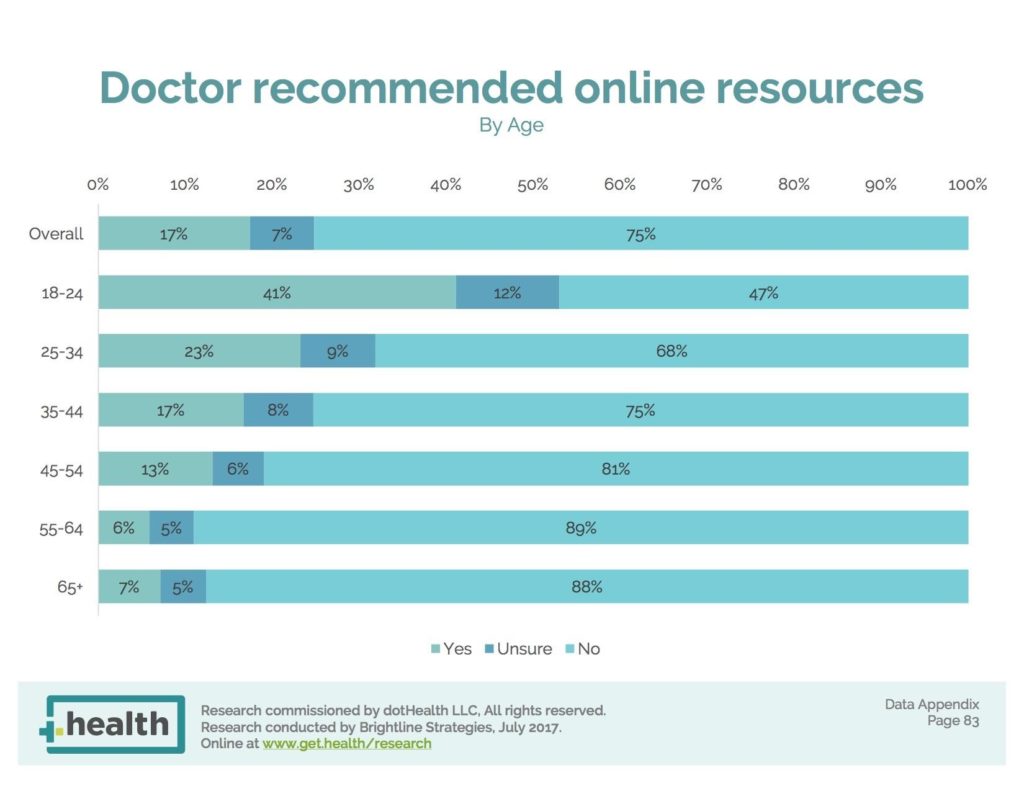 Additionally, the number one most influential factor in getting a consumer to visit a particular website was a pamphlet or material that their doctor sent home with them after a visit. This is especially true for older generations: 34% of those 65+ said this was the most important factor in getting them to visit a particular health-related website (vs. just 13% of 18- to 24-year-olds).
Additionally, the number one most influential factor in getting a consumer to visit a particular website was a pamphlet or material that their doctor sent home with them after a visit. This is especially true for older generations: 34% of those 65+ said this was the most important factor in getting them to visit a particular health-related website (vs. just 13% of 18- to 24-year-olds).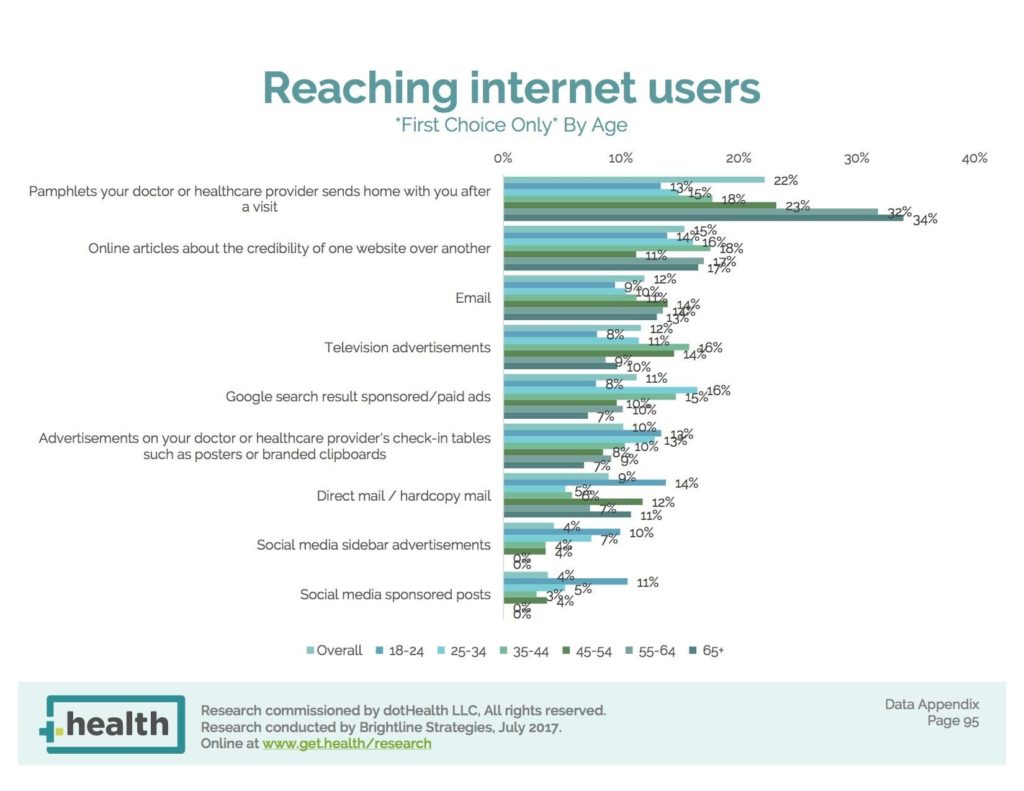 In terms of judging the credibility of a health-related website, respondents said the criteria most important to them were: (1) that it contains information endorsed by a reputable third-party; (2) that it had relevant information; and (3) that it was well known. When we asked specifically about red flags for determining a website’s credibility, the number one red flag was containing information that was not approved by a reputable third-party. This all reinforces the importance of citing reputable sources on consumer health websites in order to gain consumer trust.
In terms of judging the credibility of a health-related website, respondents said the criteria most important to them were: (1) that it contains information endorsed by a reputable third-party; (2) that it had relevant information; and (3) that it was well known. When we asked specifically about red flags for determining a website’s credibility, the number one red flag was containing information that was not approved by a reputable third-party. This all reinforces the importance of citing reputable sources on consumer health websites in order to gain consumer trust. Asking about the likelihood to click on health information links within a Google search turned up interesting results. Fifty-three percent of respondents in the 18- to 24-year-old age group said they were most influenced on clicking a URL by it simply being the first or top link in the result, versus just 18% of those 65 and older reporting the same. However, the results flip with the influence of the website description and keywords—only 9% of those 18 to 24 said that the search description was their key influencer, versus 45% of those 65+.
Asking about the likelihood to click on health information links within a Google search turned up interesting results. Fifty-three percent of respondents in the 18- to 24-year-old age group said they were most influenced on clicking a URL by it simply being the first or top link in the result, versus just 18% of those 65 and older reporting the same. However, the results flip with the influence of the website description and keywords—only 9% of those 18 to 24 said that the search description was their key influencer, versus 45% of those 65+. For more details on each of these findings and additional aspects of consumer health online, broken down by age, gender, income level, and disease/condition, visit http://get.health/research.
For more details on each of these findings and additional aspects of consumer health online, broken down by age, gender, income level, and disease/condition, visit http://get.health/research.








